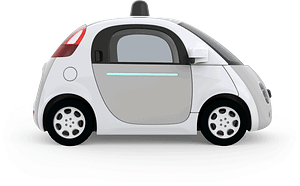 Chances are that you’ve heard a constant buzz in the news about self driving cars. Companies such as Tesla (NASDAQ:TSLA), Uber, BMW (ETR:BMW), Ford (NYSE:F), Google (NASDAQ:GOOGL), Audi (ERT:NSU), and General Motors (NYSE:GM) have all either begun or announced autonomous car initiatives over the past few years. With such a concerted effort to develop and enhance this technology, it will undoubtedly become part of our daily lives during the next 10 years.
Chances are that you’ve heard a constant buzz in the news about self driving cars. Companies such as Tesla (NASDAQ:TSLA), Uber, BMW (ETR:BMW), Ford (NYSE:F), Google (NASDAQ:GOOGL), Audi (ERT:NSU), and General Motors (NYSE:GM) have all either begun or announced autonomous car initiatives over the past few years. With such a concerted effort to develop and enhance this technology, it will undoubtedly become part of our daily lives during the next 10 years.
Our goal of this post is to provide you with a brief overview of how the technology behind self-driving cars works.
1. Where am I and where do I want to go?
The driver would input a destination or multiple destinations in an on-dash computer (or via their cell phone) in order to have the vehicle plan its trip. This could use technology similar to the FieldLogix Goose mobile application.
2. Plan my trip
The system would use GPS technology to determine its current location and the coordinates for the final destination. It would then use software and a mapping solution to plan the route as well as account for potential obstructions to the route including construction zones and traffic congestion.
3. Start driving and stay alert
As everyone knows, it is fairly easy to create a plan, but it often very difficult to stick to the plan due to distractions and unforeseen events. When driving, these distractions and unforeseen events come in the form of road hazards, pedestrians, or other poor drivers. Typically, when humans drive, our job is to keep aware of our surroundings and course correct when unanticipated events occur. However, we aren’t always the best at keeping aware of our surroundings due to our physical limitations and in-vehicle distractions. Autonomous vehicle technology is always precise and focused by using a combination of radar and lasers to monitor your driving lane and surrounding area. Radar operates much like peripheral vision and monitors a wider area (such as multiple lanes on the highway) and will detect something that is not in the immediate vicinity, but could impact your travel route (i.e. an accident 3 lanes over). Lasers monitor items closer in proximity. This could include the vehicle in front of you that suddenly stops or the vehicle in the next lane that is merging into your lane without warning. The technology also uses high performance cameras to detect things like traffic signals, road signs, etc.
4. How do I respond to unforeseen events?
Once the sensors detect items that you must respond to, it needs very sophisticated intelligence in order to make judgments on how to respond. This is the most challenging part of the technology. For example, what is the best reaction when an accident occurs 3 lanes over? Do you stop the vehicle? Do you swerve into the next lane? Do you continue on your path as if nothing happened? Any of these decisions could potentially cause you to become part of the accident or cause another accident. Autonomous vehicles use a type of artificial intelligence that would calculate the result of any of these actions within milliseconds and select the response with the most probable positive outcome. Sometimes it could be wrong, but will likely be wrong a significantly lower percentage of time than the decisions that human drivers make. As you know, humans aren’t typically the best at reacting to these types of events and we are even worse when distracted, under the influence, or just poor drivers.
5. Complete the trip
The final part is getting you to your destination safely and on time. GPS tracking and mapping software are both key to this part of the process. The navigation software knows where you are going and will guide you to your destination. Items 1 through 4 have to be accomplished with precision for this to happen. It would also be interesting to see how the technology would factor in parking etiquette as well as avoiding reserved parking spaces.
With so much effort and money behind the development of self-driving vehicles, it is only a matter of time before it becomes commonplace. It will result in safer roads and the ability to put more vehicles on smaller highways and roads. The key question is who will commercialize the technology first and change the way we get to our destinations.